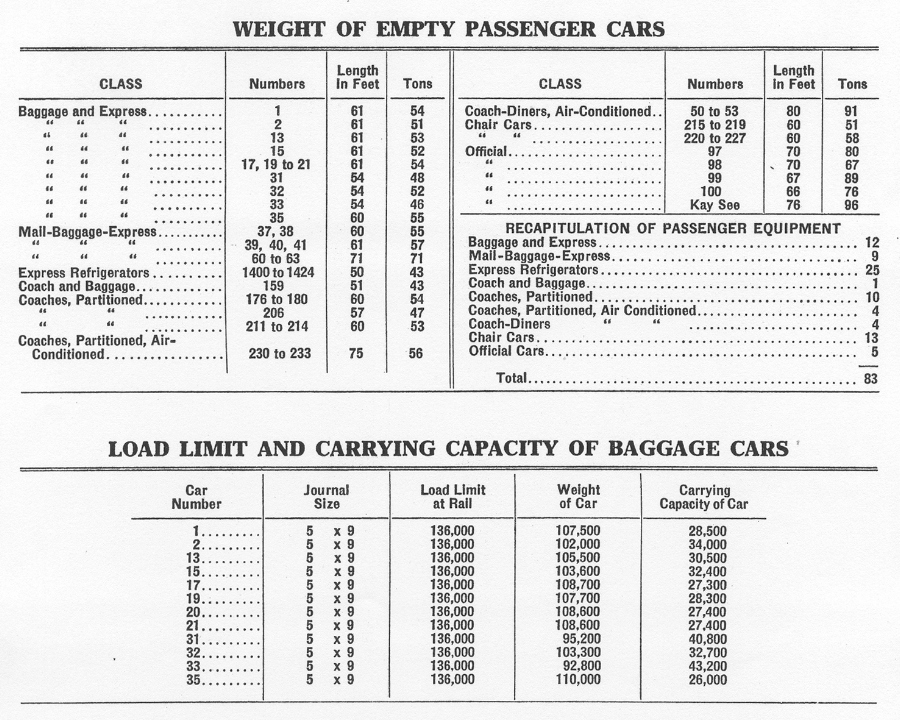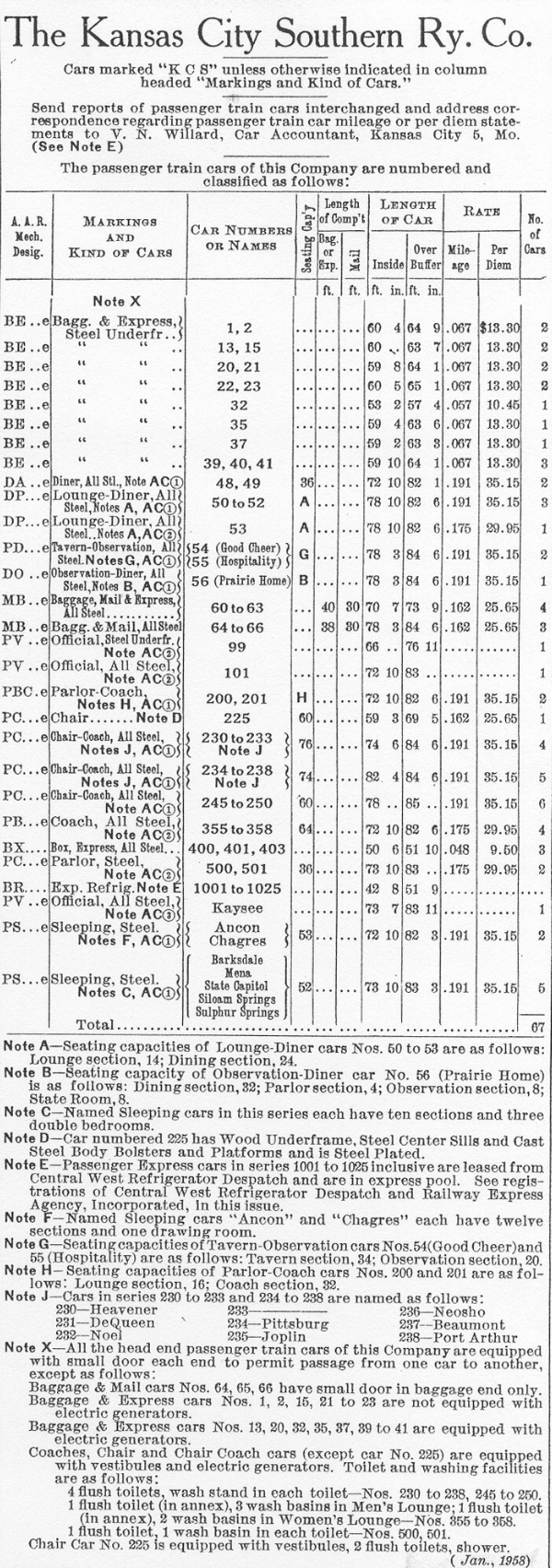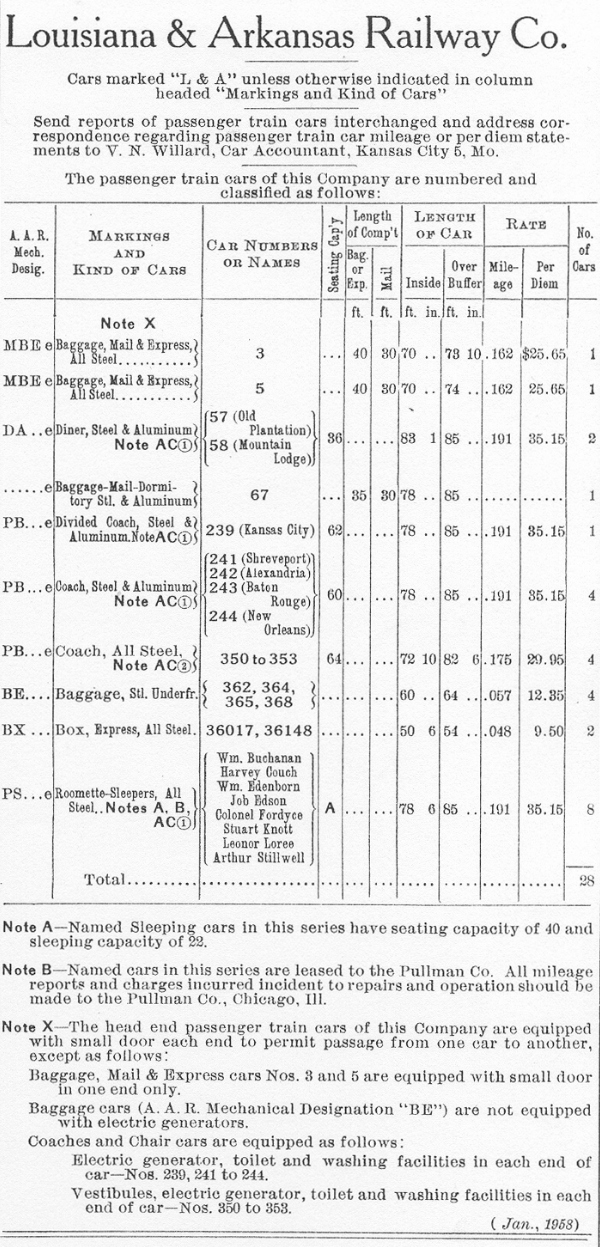
Completed in 1907, this was the last “first class” railroad to reach New Orleans. One man built and owned it, a rare event in railroad building, which almost always requires stock subscriptions and large loans. This one man was William Edenborn, who arrived from Germany in 1867 at the age of 19. This exceptionally brilliant man built a fortune developing barbed wire and nails. In less than forty years, he had enough money to build an impressive railroad.
The LR&N tied the Northwest and Southeast parts of Louisiana, from Shreveport to New Orleans, with steel rails of commerce. The important cities of Alexandria and Baton Rouge, the state's capital, and the rich, productive area across the state's diagonal, had been served by a single railroad. The new road was 306.5 miles in length, 16.3 miles closer than its rival, the Texas & Pacific, which covered the same route with 322.8 miles, avoiding the state capital! Both railroads crossed the Mississippi River by their own car ferry service. The T&P crossed at Gouldsboro, a 35 minute passage almost adjacent to its station at the foot of Thalia St. — replaced in 1916 by the Trans-Mississippi Terminal at Thalia & Annunciation. The LR&N's crossing was of several miles, from Naples on the Red River, to the Mississippi at Angola, and covered two hours and 35 minutes.
The first station of the LR&N in New Orleans was on S. Carrollton near Athletic Park baseball park and Tulane Ave. The St. Charles and Tulane Belts were a few yards' walk. On January 31, 1909 Mr. Edenborn's trains began using the Terminal Station at Canal & Basin Streets. On May 11, 1924, the road began using its own station, a modest brick one-story facility on S. Rampart at Girod.
Little is available illustrating the LR&N's passenger equipment. Their September 3, 1922 timetable boasted “Pullman-Buffet Service” all the way from Shreveport to New Orleans. Lots of railroads used the Pullman Co. for providing meals as well as sleeping cars. Total time, Shreveport to New Orleans, was fifteen hours 35 minutes (including two hours 35 minutes by transfer boat, on which food was available). The T&P overnight train took eleven hours 55 minutes. The difference was of little consequence, for both trains were overnight runs with equivalent equipment.
In 1929 the Louisiana & Arkansas Ry. acquired the LR&N. The L&A President was Mr. Harvey Crowley Couch, who had financial connections with the Arkansas Light & Power Co. and the Pine Bluff Co., a city railway. Mr. Couch inaugurated two popular “name trains”, Shreveport to St. Louis, the “Shreveporter” on Dec. 30, 1928, and in the depth of the Great Depression, the “Hustler”, Shreveport to New Orleans, on July 2, 1932. Both were overnight trains with first class accommodations, dining and sleeping cars in the consist. The “Hustler” even carried a car with valet service, offering shower baths. The train was a provider of fast service for express packages and fresh produce for restaurants and hotels. “Standard” Pullman equipment and all-steel cars were used.
The first run of the “Hustler” was a momentous event. The Shreveport Times in a long article praised the service. So popular was the event that two sections were required to provide seats and berths. “`Hustler' on first trip”. Harvey Couch rode, one of over 200 Pullman and 600 coach passengers. The train had all the features of a modern train: parlor, cafe, lounge-observation cars (S. Times, 7/3/1932, p. 9, c. 7). An earlier Times article (6/26/1932, p. 10, c. 5) describing the train's coming attractions: “overnight passenger, mail, express and baggage cars, package merchandise service...permitting merchants to receive overnight shipments from wholesale centers and farmers to get produce to cities in mornings.”
Another merger saw the Kansas City Southern of William N. Deramus III enter the picture. Mr. Deramus was quite progressive, and inaugurated the “Southern Belle” Kansas City to New Orleans streamliner in 1940, replacing the “Hustler”. American Car & Foundry equipment was purchased. In 1949, the train was re-equipped with new AC&F cars. In April of 1954, the KCS began using the new Union Passenger Terminal on S. Rampart at Howard Ave. The KCS ordered ten new coaches from AC&F in 1965, the last U. S. road to buy coaches of conventional light-weight car construction (JW p. 183, caption KCS car 274, exterior and interior images). In only four years, after the roads with which it connected and interchanged passengers discontinued their services, the “Southern Belle” made its last departures from both Kansas City and New Orleans November 2, 1969. The last arrival at New Orleans was the next day.
The KCS-L&A tried valiantly to continue passenger service as long as possible. But besides losing interchange passengers, the important mail contracts were captured by trucking interests and expanding air services' carrying capacity. There were insufficient number of local users of rail service, and as time passed, even parallel bus operations began curtailing their runs. The KCS has preserved and kept in finest repair a train of its streamlined equipment and matching diesel power for inspection trips, in the striking red and black “Southern Belle” livery. This train operates on frequent trips and attracts much attention.
KCS passenger equipment began appearing in New Orleans with the KCS-L&A combination and inauguration of the “Southern Belle” Kansas City — New Orleans streamliner in 1940. In 1938 the KCS began modernizing by adding four “American Flyer” coaches, builder not verified, but possibly Pullman (see list below). But the cars for the “Belle” were American Car & Foundry products, put in service in 1940. The same carbuilder made the equipment for the new “Southern Belle”, three trainsets, AC&F built, going into service in April of 1949. The older streamlined coaches of the first “Belle” were used to improve 15/9 and 16/10, the “Flying Crow” Kansas City — Shreveport — Port Arthur — New Orleans.
The KCS printed in each employees' timetable a roster of passenger cars, length and weight, but no other details of builders or acquisition dates. So, much research is needed to have a roster comparable to those of streetcars. Railroad historians have put together locomotive rosters equal to the comprehensive streetcar and interurban rosters, but alas, research in this field is facing a huge task to identify equipment by carbuilder. Indispensable to such a survey is John White's The American Railroad Passenger Car (reference JW).
Below are two KCS car rosters from Southern Division Employees' Timetables and the KCS roster in the January 1958 The Official Register of Passenger Train Equipment, with some “in between” timetables noting cars deleted and those added.
Timetable 25 — 6/12/1938

| Timetable 27 — 05/14/1939 | — 33, 206 gone |
| Timetable 28 — 07/16/1939 | — 18 gone |
| Timetable 29 — 05/26/1940 | — 216, 217 gone |
| Timetable 31 — 08/31/1941 | — 31, 98, 211, 215, 218, 219 gone |
| — Additions: 64 to 66 Mail Baggage Express, 85', 48T | |
| — Additions: 54 to 56 Diner Lounge Observation | |
| — Additions: 234 to 238 Coaches, Partitioned, Air Conditioned | |
| Timetable 33 — 01/05/1942 | — 180 gone |
| Timetable 34 — 11/29/1942 | — 1400-1424 gone |
| Timetable 36 — 10/22/1944 | — 100 gone, 17 gone or REN, 22 new addition or 17 REN |
| Timetable 37 — 10/28/1945 | — Addition: 23 Baggage & Express, 61', 54T |
| Timetable 41 — 10/01/1950 | — 159, 178, 179, 225 gone |
| — Many additions for new “Southern Belle” |

| The Official Register of Passenger Cars, January 1958 | |
 |
Note coaches named, as well as sleeping cars and 54 to 56. Some cars purchased under Louisiana & Arkansas title; see following Rosters of Louisiana & Arkansas Ry. Co. Passenger Equipment. |
| Types of air conditioning indicated by the following notes:
AC1 Electro-Mechanical AC2 Ice System AC3 Waukesha AC4 Steam Ejector | |
The name “American Flyer” pertains to toy train passenger equipment copied from the original plan, presumed to be Pullman. Cars were named for locations the KCS-L&A served, and the sleeping cars were named for railroad presidents. These cars used a rust-resistant alloy known as “Cor-Ten” (JW pp. 177-178). Some roads buying these were Seaboard Air Line, Boston & Maine, and New York New Haven & Hartford. Some of these were purchased by the U. S. Government to aid South Korea's recovery after the 1953 armistice and were seen running in 1958 by author Hennick on a training exercise!
In 1965, KCS added ten new streamliner cars which turned out to be the last of those classified as “conventional lightweight car construction” (nos. 270-279). White has a description with exterior and interior illustrations (JW, pp. 183-84).
One curiosity was several “standard” Pullman cars purchased and repainted in KCS colors, used as comfortable chair cars, which made the trip to New Orleans frequently in the 1940s and 1950s. Three stainless steel Budd observation-lounge-dining cars were purchased second hand from the NYC, originally used on the “Mercury”, and used daily on trains 9-10 to New Orleans until suspension in 1968. Much of the KCS passenger equipment supposedly was sold to Mexico.
The present day sees the KCS frequently operating its inspection train, consisting of impeccably maintained and serviced cars, making trips all along the greatly expanded system, keeping alive the splendid reputation of good service the KCS-L&A achieved until the last passenger train was discontinued in 1969, forty-seven years ago.
Unlike the KCS, the L&A did not incorporate passenger equipment descriptions in its employees' timetables until 1944.
Timetable 33 — October 22, 1944
This, and all L&A timetables, are from the Louis Hennick collection.

Two years later, L&A timetable 35 — September 1, 1946 — showed one car gone, no. 25, and no additional equipment.
In April 1949, the new “Southern Belle” inauguration saw equipment arriving bearing the L&A Ry. corporate title. (The KCS continued the apparent semi-independence of the L&A, but this identity slowly waned through the following years.) Timetable no. 37 — June 26, 1949 has the changes: gone were 9, 12, 34, 35, 38, 40, 41, 43, 45, and 202. New were: Mail, baggage, and express 36017, 50'8¼" length, 25 tons; Coaches, air conditioned 82' length 84 tons nos. 350-353, four cars apparently in the KCS series 355-358 (but no photos for comparison are yet available). The L&A cars had ice system AC, thus they are older than 1949, so it is doubtful they were built that year.
L&A timetable 38 — October 1, 1950 still lists old cars 42, 44, and 46! More cars went to scrap soon after. Timetable 39 — January 20, 1952 saw 42 and 46 absent, but the rest were there, including the open platform observation-lounge-diner “Magnolia” which was a regular part of the “Shreveporter” but had become an officers' car circa 1940.
| The Official Register of Passenger Cars, January 1958 | |
 |
The January 1958 Official Register of Passenger Cars illustrates how the KCS assigned cars to the L&A roster, moved from the KCS roster. (See KCS Southern Division no. 42 of January 20, 1952, companion to L&A no. 39 of the same date.) |
| Types of air conditioning indicated by the following notes:
AC1 Electro-Mechanical AC2 Ice System AC3 Waukesha AC4 Steam Ejector | |
The genealogy of most passenger equipment can be researched with success in Railway Age and other publications, such as Railroad Gazette. Car orders are commented upon, often with photos, drawings, and complete descriptions. Hopefully railroad historians will begin this work with earnest, and soon.
Copyright © 2015, 2016 Louis C. Hennick. All rights reserved.
Computer Science Department, University of Illinois at Urbana-Champaign, Home Page